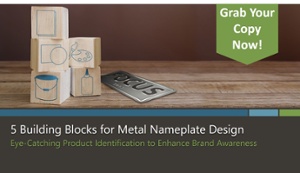No matter if you are brand new to product identification or well seasoned in pulling together the specifications for your label, there are certain pieces of information that each project needs. The material, part size and shape, artwork file, attachment method, and any enhancements are all parts of the communication between you and your supplier that are needed in order to achieve an attractive and impressive nameplate or label.

Substrate
The most common metal used for nameplates, ID Plates and badges is aluminum since it is lightweight and recyclable. Other metals like brass or stainless steel can be used depending on the type of application. Lightweight flexible plastic materials can be reviewed as well, especially if backlit graphics or functional buttons are needed.
Material Options |
Thickness and Finish |
|
Aluminum
|
.002" Matte and Bright Foil .012"-.032" Miff Finish and Bright .012"-.063" Anodized .062"-.090" Mill Finish |
|
Stainless Steel
|
.018"-.036" Brushed |
|
Polycarbonate
|
.005"-.030" Clear, Velvet, Weatherable |
|
Polyester
|
.002" White, Clear, Matte Silver, Brushed Silver, Bright Silver, Imprintable, Reflective .005"-.010" Clear |
|
Vinyl
|
.002"-.004" Standard .007" Static Cling .010"-.065" Rigid |
Size and Shape
The options in size and shape for nameplates are wide open and it is not necessary to feel trapped by standards. You can design an emblem to follow common shapes; or step out of the box by using the shape to draw attention, stand out from the crowd and enhance the product design. Size is just as flexible. Keep in mind what you need to display for graphics and text to make sure these are legible and clear.
Artwork Files
The artwork file is one of the most important pieces of communication with your nameplate supplier. This details the dimensions, colors, decoration, and graphics that are needed so that your message and look is carried to the market correctly.
- Color - Specify color with specific Pantone (PMS) color and their locations. If PMS color is not available, provide a reference to the color target. A McLoone standard color may be used. A color chip may be necessary for review and sign off.
- Fonts - Convert all fonts to curves and include with the artwork files to avoid any discrepancies.
- Gloss Level - Specify whether all over or selective and if low (matte) or high gloss is required.
-
Graphics and images - Save all images at high resolution, at 100% scale and in vector format. Be sure to have a minimum line thickness of .007" and keep any graphic or text at least .045" away from any edge or cutout area.
Attachment Options
Whether you are designing a flat metal nameplate, backlit polycarbonate overlay or an embossed product identification badge, attachment to the product should be one of the checklist items to review. A secure bond with adhesive is a common solution. Metal nameplates can be tooled with holes or notches to accommodate attachment with rivets or screws.
Impact with Enhancements
There are several options for enhancements that increase the impact of your nameplate. These durable processes are available for both metal and plastic substrates, giving you versatility and opportunity to design unique branding components.
-
Embossed Graphics or Text - Embossing metal nameplates is a great way to add dimension and focus to the brand. Embossed buttons on graphic overlays are functional and attractive.
-
Domed Labels - Custom domed labels are a simple and cost effective solution for your product identification, making your company logo or product name pop
-
Incorporate a Pattern or Background Finish - Patterns and finishes add interest to product branding. Options include technical metal finishes, attractive faux finishes as well as attention grabbing surface decoration with contrasting gloss levels or metallic inks.
How Can We Help?
Whether your needs are a basic and functional identification tag or a more complex and decorative nameplate to build brand awareness, we can help. Your brand is worth the attention to design an attractive and compelling part. All your nameplate and label needs are met from a single source with McLoone. Let’s discuss how your product identification can move from concept to reality.
Related Posts
5 Important Aspects of Nameplate Design
3 Things to Expect from a Nameplate Design Project
5 Artwork Requirements for Effective Nameplate and Label Design



